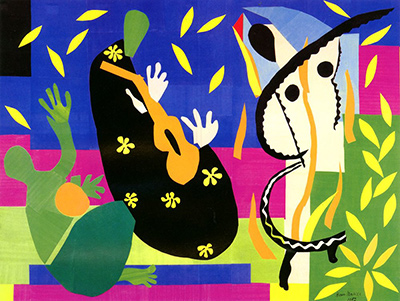Created in 1952, just two years before his death, The Sorrows of the King was Henri Matisse’s final self-portrait and many critics consider this to be his most innovative period.
Referencing one of Rembrandt’s canvases, David Playing the Harp before Saul, in which the young biblical hero plays to divert the king away from his sadness, as well as to the Dutch master’s late self-portraits. Here Matisse portrays the themes of old age, of reflecting on earlier life and of the soothing caress of music.
Matisse is represented by the central black silhouette sitting in an armchair, surrounded by the pleasures of an enriched life. A number of recurring themes from Matisse’s life are present: the yellow petals have the gaiety of musical notation, the green exotic woman symbolises the Orient and a dancer serves to celebrate the female body and sensuality.
During his final years Matisse was forced to endue severe arthritis and had cancer, which confined him to a wheelchair. Instead of surrendering his artistic talent when he was no longer able to stand and hold a paintbrush, the artist instead created paintings with scissors. He cut up pieces of colourful paper painted with gouache and glued them on to larger sheets with the help of his studio assistants. These ‘gouaches découpés’ used stunning colours and shapes to create a cut-out collage scene.
The Sorrow of the King is a fine example of this style. The blending and contrasting of blues, greens, magentas, and yellows in this piece shows Matisse's mastery over the years. The Sorrow of the King was exhibited in 1952 at the Salon de Mai, where it was purchased by Jean Cassou and Georges Salles.




